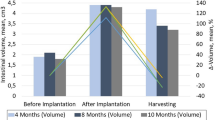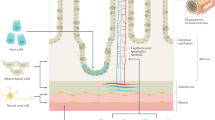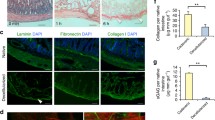Abstract
A promising therapeutic approach for intestinal failure consists in elongating the intestine with a bio-engineered segment of neo-formed autologous intestine. Using an acellular biologic scaffold (ABS), we, and others, have previously developed an autologous bio-artificial intestinal segment (BIS) that is morphologically similar to normal bowel in rodents. This neo-formed BIS is constructed with the intervention of naïve stem cells that repopulate the scaffold in vivo, and over a period of time, are transformed in different cell populations typical of normal intestinal mucosa. However, no studies are available to demonstrate that such BIS possesses functional absorptive characteristics necessary to render this strategy a possible therapeutic application. The aim of this study was to demonstrate that the BIS generated has functional absorptive capacity. Twenty male August × Copenhagen-Irish (ACI) rats were used for the study. Two-centimeter sections of ABS were transplanted in the anti-mesenteric border of the small bowel. Animals were studied at 4, 8, and 12 weeks post-engraftment. Segments of intestine with preserved vascular supply and containing the BIS were isolated and compared to intestinal segments of same length in sham control animals (n = 10). d-Xylose solution was introduced in the lumen of the intestinal segments and after 2 h, urine and blood were collected to evaluate d-Xylose levels. Quantitative analysis was performed using ELISA. Morphologic, ultrastructural, and indirect functional absorption analyses were also performed. We observed neo-formed intestinal tissue with near-normal mucosa post-implantation as expected from our previously developed model. Functional characteristics such as morphologically normal enterocytes (and other cell types) with presence of brush borders and preserved microvilli by electron microscopy, preserved water, and ion transporters/channels (by aquaporin and cystic fibrosis transmembrane conductance regulator (CFTR)) were also observed. The capacity of BIS containing neo-formed mucosa to increase absorption of d-Xylose in the blood compared to normal intestine was also confirmed. With this study, we demonstrated for the first time that BIS obtained from ABS has functional characteristics of absorption confirming its potential for therapeutic interventions.






Similar content being viewed by others
References
Ueno T, Fukuzawa M. Current status of intestinal transplantation. Surg Today 2010;40:1112-1122
Spurrier RG, Grikscheit TC. Tissue engineering the small intestine. Clin Gastroenterol Hepatol. 2013;11(4):354-8. doi: 10.1016/j.cgh.2013.01.028.
Seguy D, Vahedi K, Kapel N, Souberbielle JC, Messing B. Low-dose growth hormone in adult home parenteral nutrition-dependent short bowel syndrome patients: a positive study. Gastroenterology. 2003;124(2):293-302
Scolapio JS, Felming CR, Delly DG, et al. Survival of home parenteral nutrition-treated patients: 20 years of experience at Mayo clinic. Mayo Clin Proc 1999; 74:217-22
Sawchuck A, Goto S, Yount J, Grosfeld J.A., Lohmuller J, Grosfeld M.D.,Grosfeld J.L. Chemically induced bowel denervation improves survival in short bowel syndrome. J Pediatr Surg. 1987;22(6):492-6
Grant D, Abu-Elmagd K, Reyes J, Tzakis A, Langnas A, Fishbein T, Goulet O, Farmer D; on behalf of the Intestine Transplant Registry. 2003 report of the intestine transplant registry: a new era has dawned. Ann Surg. 2005; 241(4):607-13
Nakao M, Ueno T, Oga A, Kuramitsu Y, Nakatsu H, Oka M. Proposal of intestinal tissue engineering combined with Bianchi's procedure. J Pediatr Surg. 2015;50(4):573-80. doi: 10.1016/j.jpedsurg.2014.11.035
Bianchi A. Intestinal loop lengthening: a technique for increasing small intestine length. J Pediatr Surg1980;15:145–51.
Kim HB, Fauza D, Garza J, Oh JT, Nurko S, Jaksic T. Serial transverse enteroplasty (STEP): a novel bowel lengthening procedure. J Pediatr Surg. 2003;38(3):425-9
Messing B, Crenn P, Beau P, et al. Long-term survival and parenteral nutrition dependence in adult patients with the short bowel syndrome. Gastroenterology. 1999, 117:1043-1050.
Choi RS, Vacanti JP. Preliminary studies of tissue-engineered intestine using isolated epithelial organoid units on tubular synthetic biodegradable scaffolds. Transplant Proc 1997;29:848–51.
Kim SS, Kaihara S, Benvenuto M, et al. Regenerative signals for tissue-engineered small intestine. Transplant Proc 1999;31:657–60.
Kaihara S, Kim SS, Kim BS, et al. Long-term follow- up of tissue-engineered intestine after anastomosis to native small bowel. Transplantation 2000;69:1927–32.
Pahari MP, Raman A, Bloomenthal A, Costa MA, Bradley SP, Banner B, Rastellini C, Cicalese L. A novel approach for intestinal elongation using acellular dermal matrix: an experimental study in rats. Transplant Proc. 2006;38(6):1849-50.
Pahari MP, Brown ML, Elias G, Nseir H, Banner B, Rastellini C, Cicalese L. Development of a bioartificial new intestinal segment using an acellular matrix scaffold. Gut. 2007;56(6):885-6.
Ansaloni L, Bonasoni P, Cambrini P, Catena F, De Cataldis, A. Gagliardi S, Gazzotti F, Peruzzi S, Santini D, Taffurelli M. Experimental evaluation of Surgisis as scaffold for neointestine regeneration in a rat model. Transplantation Proceedings, 2006, 38, 1844-1848.
Andrée B, Bär A, Haverich A, Hilfiker A. Small intestinal submucosa segments as matrix for tissue engineering: review. Tissue Eng Part B Rev. 2013;19(4):279-91. doi: 10.1089/ten.TEB.2012.0583. Epub 2013 Jan 14.
Grant CN, Mojica SG, Sala FG, Hill JR, Levin DE, Speer AL, Barthel ER, Shimada H, Zachos NC, Grikscheit TC. Human and mouse tissue-engineered small intestine both demonstrate digestive and absorptive function. Am J Physiol Gastrointest Liver Physiol. 2015;308(8):G664-77.
Sato T, van Es JH, Snippert HJ, Stange DE, Vries RG, van den Born M, Barker N, Shroyer NF, van de Wetering M, and Clevers H. Paneth cells constitute the niche for Lgr5 stem cells in intestinal crypts. Nature 469: 415-418, 2011.
Melendez J, Liu M, Sampson L, Akunuru S, Han X, Vallance J, Witte D, Shroyer N, and Zheng Y. Cdc42 coordinates proliferation, polarity, migration, and differentiation of small intestinal epithelial cells in mice. Gastroenterology 145: 808-819, 2013.
Noel J, Roux D, and Pouysségur J. Differential localization of Na+/H+ exchanger isoforms (NHE1 and NHE3) in polarized epithelial cell lines. J Cell Sci 109 (Pt 5): 929-939, 1996.
Laforenza U. Water channel proteins in the gastrointestinal tract. Mol Aspects Med 33: 642-650, 2012.
Stevens FM, Watt DW, Bourke MA, McNicholl B, Fottrell PF, McCarthy CF. The 15 g D-xylose absorption test: its application to the study of coeliac disease. J Clin Pathol. 1977;30(1):76-80.
Author information
Authors and Affiliations
Corresponding author
Additional information
Primary Discussant
Dr. Ali Tavakkoli, M.D. (Boston, MA)
I would like to congratulate Dr. Cicalese and team on their excellent presentation. Our current management of short bowel syndrome (SBS) is based on total parental nutrition (TPN) which was developed following some pioneering surgical research 50 years ago. Although TPN has saved many lives since its introduction, it is associated with risks. This highlights the importance of work such as that just presented to help improve the future care of our patients with SBS and intestinal dysfunction. In this presentation, you show that by implanting acellular scaffolds, you can create a neo-mucosa that is morphologically similar to native bowel with polarized enterocytes with apical and basal membrane characteristics. You also show that the segments have absorptive capacity, which is critical as you move the project toward a therapeutic approach. I do have two questions:
- You have used Surgisis for these studies, but would other biological scaffold currently available for hernia repair lead to similar results?
- You used very short segments of the intestine for your perfusion studies (2.5 cm) and showed that the d-Xylose absorption increased in the implanted groups. However, this is likely to be an insignificant increase if you evaluate the whole intestinal length. Since your ultimate goal is to translate this to an SBS model, how many of these acellular scaffolds do you need to place to increase overall intestinal absorptive capacity, how will they be placed and what are the consequences of increased scaffold implants on intestinal motility?
Thank you and congratulations on an interesting study.
Closing Discussant
Dr. Cicalese
1. Yes, we have also used decellularized human dermal scaffold (Alloderm) in other previous experiments and had similar results with near-normal neo-mucosa formation. In our previous studies, we have not evaluated absorption but only morphology. We believe that any biologic, reabsorbable, and non permeable scaffold could bring similar results but we have not tested other materials at this time.
2. The goal of the present study was only to demonstrate absorption in the intestinal segment containing the graft and not to reverse SBS. I agree that longer scaffold segments would be needed to obtain significant increase in absorption in a clinical setting. In my opinion, the exact amount of scaffold needed for each patient (and consequently neo-intestine formed) will depend on a number of individual factors such as total length of the residual small intestine and presence or absence of the ileo-cecal valve for example. The total amount of the intestine after the development of the neo-intestinal structure should be estimated to be at least equivalent to 1 m or more to ensure sufficient absorption of nutrients and fluids based on intestinal rehabilitation data and our living donor segmental intestinal transplant experience. These scaffolds could be transplanted in the anti-mesenteric border (as described in this paper) or as tubular structures in sequence between residual normal bowels to utilize the peristalsis generated by the native intestine. In several animal experiments that we performed using both the method described in this paper as well as a tubular segment placed directly in continuity with the native intestine, we did not observe dilatation of the proximal intestine, obstruction, or other motility problems.
Rights and permissions
About this article
Cite this article
Cicalese, L., Corsello, T., Stevenson, H.L. et al. Evidence of Absorptive Function in vivo in a Neo-Formed Bio-Artificial Intestinal Segment Using a Rodent Model. J Gastrointest Surg 20, 34–42 (2016). https://doi.org/10.1007/s11605-015-2974-1
Received:
Accepted:
Published:
Issue Date:
DOI: https://doi.org/10.1007/s11605-015-2974-1




